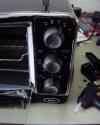Bert Sierra
Member Since: February 7, 2015
Country: United States
-
Great article. I would think that a high-ampere solid state triac might be more suitable than a relay for this design. I would put in considerable overkill on the specs, given the spikes and surges that can come down AC lines. A 600V 25A triac will run about $5 from most vendors and would have plenty of headroom to control a 1500W oven. For the sake of safety, it might be wise to add an opto-isolator to control the triac’s gate, thus isolating the low voltage and AC sides completely. Best of all: triacs don’t tend to produce much heat, though you’d want to study the specs to make sure it could withstand heat produced within the oven.
A simple design would simply switch the heating elements on or off as needed (triacs don’t actually turn off until the next zero crossing of the AC current occurs, so there’s a bit of delay). A more sophisticated design would analyze the AC voltage to allow the power to be turned on within each 50Hz / 60Hz cycle at a specific phase. By doing so, you could vary the power being delivered to the heating elements for more precise control of the oven’s temperature. [More power when heating up, less power to maintain a particular temperature, for example.]
Just a thought. Relays to control that much current may not last as long as an equivalent triac, and a triac would occupy far less area on the circuit board.
-
No heatsink included? The SoC on the Raspberry Pi 3 runs considerably hotter than on RPi2 boards. I wouldn’t put it in a case without a nice heatsink, and furthermore a heatsink mounted with thermal adhesive and not merely double-sided tape.
No public wish lists :(

